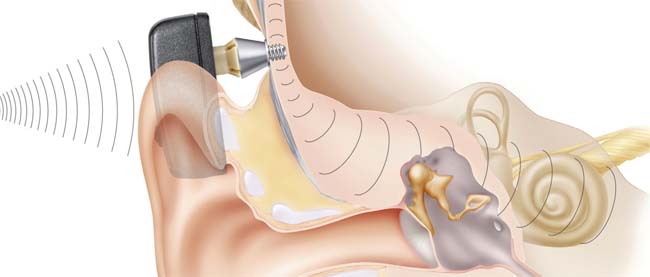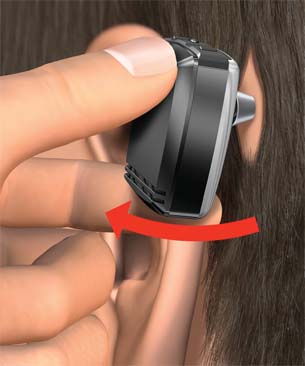Autodesk Inventor Dispels Sounds of Silence
Designs that Will Change the World, First Place: Cochlear uses advanced technology to design and develop a breakthrough hearing aid that opens the world of sound to the hearing impaired.
Latest News
December 1, 2009
By Tom Kevan
The winners and runners-up of DE’s Change the World Challenge all offer solutions to problems plaguing our world. All promise to have a big impact on many peoples’ lives. All are impressive in their scope regardless of simplicity or complexity.
 Figure 1: The BAHA’s sound processor picks up sound vibrations and passes then via an abutment to the implant. The abutment tranfers the sound vibrations from the processor to the small titanium implant in the bone, behind the ear. The implant transfers the sound vibrations through bone to the functioning cochlea. Image courtesy of Cochlear Ltd. |
In the Design category, the first-place winner differs from the others in this section in that it works within an already accepted framework of solutions to the particular problem it seeks to solve. This in no way detracts from the genius of the design or the accomplishments of the designers. The real import of this difference is that it doesn’t require an established and accepted infrastructure be scrapped and replaced by an out-of-the-box approach. It does not require those with significant financial interests in maintaining the status quo to step aside. It therefore has a much better chance of widespread use, and its impact is less of a question, and more of a statement.
The winner of the challenge in this category is the BAHA (Bone Anchored Hearing Implant) hearing system by Cochlear Bone Anchored Solutions, a division of Cochlear Ltd. It offers those with certain types of impairments a chance to hear and function normally in everyday life. For children, this can open the way for them to develop speech and attend school much like any other student. For many people with hearing loss, it removes a major obstacle to doing ordinary things that most of us take for granted, such as crossing a street, going to a restaurant, participating in a professional meeting, or simply driving a car. It promises to restore hearing to those that other solutions cannot help.
The scale of the problem the BAHA solves is enormous. Thirty-five million people in North America alone suffer from hearing loss. According to the Hearing Review, one in six people between the ages of 41 and 56 have a hearing problem. One in 14 between the ages of 29 and 40 suffer hearing loss. And 1.4 million children cannot hear properly. Other documentation estimates that globally, approximately 278 million people have moderate to profound hearing loss in both ears.
The Design Team
The complexity of the BAHA was matched by the composition of its design team. The group’s disciplines included mechanical, electrical, and software engineering. Because of the nature of the device, the designers needed special knowledge in the fields of signal processing and acoustics.
The team used a systems approach, which is based on the belief that the parts of a system can be best understood within the context of their relationships to each other and to the system as a whole, not in isolation. “All the BAHA’s components work very closely together,” says Mats Dotevall, Director of Design and Development for Cochlear Bone Anchored Solutions. “One of the big technical challenges was feedback. In a hearing aid like this, you have a microphone and vibrator. Sometimes when the skull bone vibrates, the signal comes back to the microphone, causing feedback. Every system component was involved in the feedback issue. So we worked very closely together as a team.”
 Figure 2: The sound processor snaps onto the abutment, which is attached to the titanium implant in the bone. Courtesy of Cochlear Ltd. |
Design Tools
The primary tool used to design the BAHA was Autodesk Inventor, a 3D parametric solid modeling software package. Cochlear adopted Inventor because it needed to be able to precisely design, engineer, and manufacture parts on scales of 1/100 or 1/1000 of a millimeter, and the software’s modeling functionality made it possible to work with very small components and tolerances.
Inventor’s 3D digital prototyping also allowed designers to visualize and simulate the product before it was built, reducing the number of physical prototypes the team had to construct, and improving the overall efficiency of the development process.
In addition to Inventor, the design team used electronics CAD systems to optimize the size and manufacturability of the circuit board, as well as acoustic, electromagnetic, and signal-processing simulation tools for modeling things such as feedback characteristics, vibrator efficiency, and sound-processing performance. The software engineers used various tools for software development, testing, and validation.
The Problem
In most cases, a person with hearing loss is fitted with a traditional hearing aid, which carries sound by air conduction, through the ear canal, eardrum, and ossicles. Traditional hearing aids use a microphone to pick up sound from the environment and convert it to an electrical signal, which is sent to an amplifier. The amplifier increases the strength of the signal (the volume of the sound) and sends it to a receiver/speaker, which changes the electrical signal back to sound and sends it into the ear.
There are situations, however, where this type of device does not work. In these cases, the person’s ear canal or the malleus, incus, and staples bones, which transmit and amplify vibrations to the eardrum and inner ear, are damaged or do not function.
The Solution
Clochear’s solution for this type of hearing loss is the BAHA system, which uses the bone the makes up the skull as an alternative sound path to enable a person to hear. Much like air, bone can conduct sound vibrations. In cases when the middle ear is blocked, damaged, or occluded, the BAHA bypasses the outer and middle ear and naturally stimulates the cochlea through bone conduction (see Figure 1). Once the cochlea receives the sound vibrations, the organ hears in the same manner as that affected through air conduction. The sound is converted to neural signals, which are transferred to the brain, allowing the person to perceive sound.
The BAHA concept of using bone to conduct sound arose when it was observed that by placing a tuning fork against an artificial tooth, anchored by a titanium implant, patients with impaired hearing could hear the sound well. Other hearing devices use bone conduction to enable hearing by pressing a vibrator against the skull, but many believe the perception of sound this way is not as good. This is because sound vibration and intensity are dampened by skin, muscle, and fat, especially the high frequencies critical for understanding speech.
The BAHA system uses a titanium implant, which is placed in the skull bone behind the ear. An abutment connects a sound processor to the implant in the bone (see Figure 2). The processor collects the sound vibrations, amplifies them, and passes them to the implant, which conducts the vibration through the skull bone to the fluid in the inner ear.
Although the Baha system has been in use since 1977, Cochlear treated it as a work in progress. As new technologies have been introduced and refined, the company’s design team took advantage of them to expand their vision of just what the hearing system could do and how it could best help those with hearing impairments. In 2003, the designers cashed in on the digital revolution by replacing the original sound processor, which relied on analog amplifiers, with a digital component. With this modification, the new Cochlear Baha BP100 model offers advanced digital signal processing and is PC-programmable, which enables a clinician to individualize the unit’s sound to best meet specific patients’ needs.
Today, almost 60,000 people can hear because of the BAHA hearing system. The number of those who could benefit from the device, however, is in the millions. The true impact of the BAHA is not expressed in numbers, though. “In the end, it is a quality of life product that makes big changes in peoples’ lives,” says Dotevall. The ability to hear transforms the social, educational, and professional facets of the lives of those who use this device.
More Info:
Autodesk Inc.
Contributing Editor Tom Kevan is based in New Hampshire and is DE’s mechatronics, PLM, and systems expert. Send your comments about this article to [email protected].
Subscribe to our FREE magazine, FREE email newsletters or both!
Latest News
About the Author
DE’s editors contribute news and new product announcements to Digital Engineering.
Press releases may be sent to them via [email protected].






